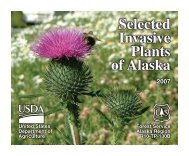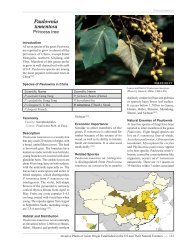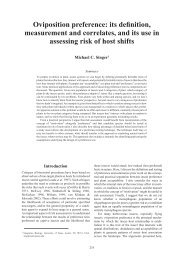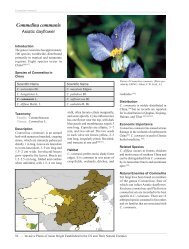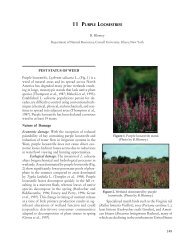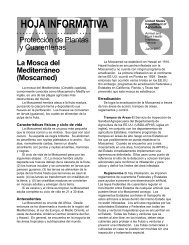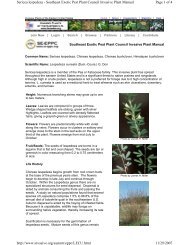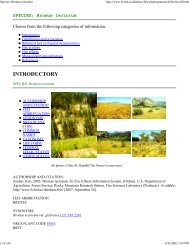A review of literature and field practices focused on ... - Invasive.org
A review of literature and field practices focused on ... - Invasive.org
A review of literature and field practices focused on ... - Invasive.org
You also want an ePaper? Increase the reach of your titles
YUMPU automatically turns print PDFs into web optimized ePapers that Google loves.
A st<str<strong>on</strong>g>and</str<strong>on</strong>g>ard mixing sequence for most herbicides that would be used in knotweed c<strong>on</strong>trol<br />
would be to add half the total amount <str<strong>on</strong>g>of</str<strong>on</strong>g> water to your spray tank, add the measured<br />
amount <str<strong>on</strong>g>of</str<strong>on</strong>g> herbicide, any surfactant (<str<strong>on</strong>g>and</str<strong>on</strong>g> dye), then the rest <str<strong>on</strong>g>of</str<strong>on</strong>g> the water. Mix carefully,<br />
but thoroughly between steps. After mixing the herbicide soluti<strong>on</strong>, follow the directi<strong>on</strong>s<br />
for foliar applicati<strong>on</strong>s <strong>on</strong> the label, which is usually to spray just enough soluti<strong>on</strong> to wet<br />
the leaves <str<strong>on</strong>g>and</str<strong>on</strong>g> stems while avoiding dripping. Try <str<strong>on</strong>g>and</str<strong>on</strong>g> spray the top surface <str<strong>on</strong>g>of</str<strong>on</strong>g> every leaf<br />
<strong>on</strong> the plant <str<strong>on</strong>g>and</str<strong>on</strong>g> the stems. The plant may take several weeks to show significant adverse<br />
effects. Do not worry or retreat, the best c<strong>on</strong>trol happens slowly. Return later in the<br />
seas<strong>on</strong> <str<strong>on</strong>g>and</str<strong>on</strong>g> again the next seas<strong>on</strong> to determine if additi<strong>on</strong>al treatments will be necessary.<br />
The right time to apply herbicides is greatly affected by herbicide choice. According to<br />
Oreg<strong>on</strong> Department <str<strong>on</strong>g>of</str<strong>on</strong>g> Agriculture materials, the ideal time to spray most deep-rooted<br />
perennials is when they are in flower bud stage. However, because knotweed may be 15<br />
feet tall when it begins to flower this is not always practical. The best time, from a<br />
practical st<str<strong>on</strong>g>and</str<strong>on</strong>g>point, is when the patches are 1-2 meters tall. Shorter plants may not have<br />
adequate leaf surface to absorb, <str<strong>on</strong>g>and</str<strong>on</strong>g> translocate, enough chemical to be effective.<br />
However, young, rapidly growing plants do have a more efficient biological process to<br />
translocate chemicals. Spraying taller plants means creating more risk <str<strong>on</strong>g>of</str<strong>on</strong>g> pesticide drift<br />
<str<strong>on</strong>g>and</str<strong>on</strong>g> older plants may not be as efficient in chemical translocati<strong>on</strong>. A spring spray or<br />
cutting will set back the plant so that it can be sprayed at an effective height <str<strong>on</strong>g>and</str<strong>on</strong>g> growth<br />
stage later in the year. Plants first encountered late in the year can be cut to 1.5 meters in<br />
height immediately before spraying, although c<strong>on</strong>trol effectiveness is somewhat reduced.<br />
TNC <str<strong>on</strong>g>field</str<strong>on</strong>g> data analysis suggest treatment d<strong>on</strong>e in April or May is not as effective as<br />
those d<strong>on</strong>e in June or July.<br />
Regardless <str<strong>on</strong>g>of</str<strong>on</strong>g> herbicide choice, rate or spray timing; large, established patches (hundreds<br />
or thous<str<strong>on</strong>g>and</str<strong>on</strong>g>s <str<strong>on</strong>g>of</str<strong>on</strong>g> stems) will almost certainly require foliar treatments over two or more<br />
years. Just as when treating patches mechanically, be sure to search for new shoots at<br />
least as far as 20 feet away from the central patch after herbicide treatment begins<br />
Herbicide: Wipe<br />
This method relies <strong>on</strong> direct applicati<strong>on</strong> <str<strong>on</strong>g>of</str<strong>on</strong>g> herbicide to plant tissue, typically using a<br />
sp<strong>on</strong>ge or brush <str<strong>on</strong>g>of</str<strong>on</strong>g> some sort. Although very slow, this approach greatly reduces or<br />
eliminates drift. This method may be useful in areas where plants are established in<br />
particularly sensitive areas or for l<str<strong>on</strong>g>and</str<strong>on</strong>g>owners who are c<strong>on</strong>cerned about spraying.<br />
Unfortunately, c<strong>on</strong>trol is generally mediocre without multiple repeat applicati<strong>on</strong>s.<br />
Wick (wipe-<strong>on</strong>) applicators - Use a sp<strong>on</strong>ge or wick <strong>on</strong> a l<strong>on</strong>g h<str<strong>on</strong>g>and</str<strong>on</strong>g>le to wipe herbicide<br />
<strong>on</strong>to foliage <str<strong>on</strong>g>and</str<strong>on</strong>g> stems. Use <str<strong>on</strong>g>of</str<strong>on</strong>g> a wick eliminates the possibility <str<strong>on</strong>g>of</str<strong>on</strong>g> spray drift or droplets<br />
falling <strong>on</strong> n<strong>on</strong>-target plants. However, herbicide can drip or dribble from some wicks.<br />
• “Paint sticks” <str<strong>on</strong>g>and</str<strong>on</strong>g> “stain sticks” sold at local hardware stores have been used<br />
successfully for wick applicati<strong>on</strong>. These sticks have a reservoir in the h<str<strong>on</strong>g>and</str<strong>on</strong>g>le that<br />
can hold herbicide, which soaks a roller brush at the end <str<strong>on</strong>g>of</str<strong>on</strong>g> the h<str<strong>on</strong>g>and</str<strong>on</strong>g>le. The brush<br />
is wiped or rolled across leaves <str<strong>on</strong>g>and</str<strong>on</strong>g> stems.<br />
• The “glove <str<strong>on</strong>g>of</str<strong>on</strong>g> death” is a technique developed by TNC l<str<strong>on</strong>g>and</str<strong>on</strong>g> stewards for applying<br />
herbicide in an otherwise high quality site. Herbicide is sprayed directly <strong>on</strong>to a<br />
heavy cott<strong>on</strong> glove worn over a thick rubber/latex (or nitrile) glove. The wearer <str<strong>on</strong>g>of</str<strong>on</strong>g><br />
17




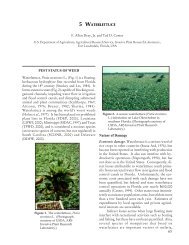

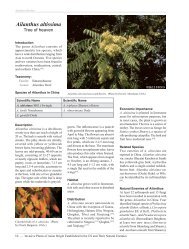
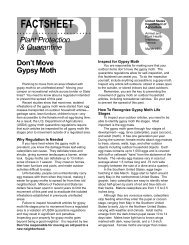
![A Guide to the Control and Management of Invasive Phragmites [PDF]](https://img.yumpu.com/27321025/1/190x190/a-guide-to-the-control-and-management-of-invasive-phragmites-pdf.jpg?quality=85)
